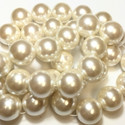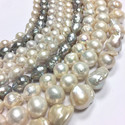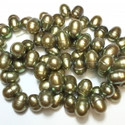All Pearl Beads
We specialize in beads for jewelry. The smooth round texture of pearl beads makes this one a pleasing addition to any jewelry making project.
If you're looking for stunning pieces that will give you lots of options for your jewelry making project, pearls are a classy choice for both the beginner and professional jewelry crafter. There are many good reasons why they are such a popular option in jewelry making.
Our largehole beads are easy to thread onto your craft and allow you to use larger beading wire, creating a more durable piece of jewelry. We also offer tiny, seed beads for those delicate projects that need a fine touch.
The pearl is the only gemstone produced in the soft tissue of a living creature. It is commonly found in oysters and mussels. The elegant stone is created by the irritation of the mantle folds inside the shelled mollusk. The formation of the pearl continues layer by layer until the shimmering gemstone is completed.
The Difference Between Natural Freshwater Pearls Versus Cultured Pearls
Natural pearls are rare since the actual formation of these iridescent stones is a defensive response by the living creature. Since they are scarce, most of the produced gemstones today are formed through the process of culturing pearls.
The Different Pearl Types
If you are into jewelry making and would like to use pearls, understanding the different pearl types and shapes is critical to your success in creating stunning pieces. Since it's difficult to find perfectly round shaped pearls, there is a wide range of different pearl styles that are based on the available shapes produced through the culturing process.
Keshi Pearls - Also known as poppy seed pearls, they are the byproducts of cultured pearl either in seawater and freshwater mollusks. You'll find them in different shapes and colors.
Freshwater Pearls - Often valued lower than saltwater pearls, these types of pearls come in a variety of shapes and colors. Since they are inexpensive and durable, they are quite popular among newcomers in the jewelry making industry. Our freshwater pearl strands are designed to be immediately incorporated into your craft.
South Sea Pearls - commonly known as the White South Sea Pearls, these saltwater pearls provide elegance to jewelry due to their unusual, smooth, and silky luster. South Sea Pearls are sensitive varieties of gemstones and have rare colors making them more expensive than the other types of pearls in the market.
History of Pearls
The pearl is considered as one of the most valued gems and talismans in different cultures dating back to ancient times. The significance and use of pearls in human culture and civilization can be traced back to as early as 6,000 years ago. The ancient civilization in the Gulf of Persia views pearls as valuable jewelry and precious gemstone. Even in death, they carry these beautiful gems with them in their graves. The ancient people of Persia and Sumer use them as trading pieces or given as tributes to kings and conquerors. Although pearls are known to dry out and deteriorate throughout the years, archaeologists were able to unearth some of the earliest pearl jewelry that survived the harsh weather.
In Egypt, there is a story circulating about how Queen Cleopatra dissolved a pearl in wine to prove to her lover, Mark Antony how she can consume the total value of a nation in one meal. Unfortunately, it was just a story since pearls don't dissolve in wine. Pearls are highly valued in Ancient Egypt and were used by Kings, Queens, and nobles as a symbol of royalty and power.
In Europe, pearls are considered as products of powerful creatures which makes them valued above other gemstones. Before the rise of the Roman Empire, these gems were quite rare and were only worn by the nobles. They became mainstream in 100 BC and were considered as fashion by almost everyone in Ancient Rome.
Between 800 and 1300 AD, the use of these beautiful gems was no longer limited to fashion as they're now used for religious purposes. They also became more significant to the medical industry since doctors began using them as medicine by crushing and mixing pearls in wine. These crushed gems were in demand since many patients paid for the pulverized pearls.
By the 1500s, pearls were made fashionable again by Henry the Eight and Elizabeth I. The production of the elegant gemstone by oysters through the process of irritation was discovered by European scientists in 1600s.
What's the Rarest Color of Pearl
Pink pearls are among the rarest natural pearl colors and are formed when an irritant triggers the defensive mechanism of the endangered queen conch snails. Due to its rarity, most pink pearls sold in the market are dyed freshwater pearls. These different colors of freshwater pearl bead strands works well for pairing with different focal beads.
Are Cultured Pearl Considered as Real Pearls?
While they are formed in an oyster farm using two different groups of mollusk and under controlled condition, cultured pearls are considered as real pearls. Instead of a natural irritant forcing its way into the shellfish, humans insert a tissue graft from other oysters to trigger the process of producing pearls.
What's the Difference Between Imitation Pearls and Cultured Pearls?
The most noticeable difference between real pearls and its imitation is the texture of the gems. The texture of the real ones is gritty with subtle ridges since they are a product of nature. On the other hand, fake pearls are smooth, blemish-free, and perfectly shaped. Our glass pearl beads are valued for their durability and ease of use when crafting.
Are Colored Pearls Real?
Yes. Colored pearls are real since some of the most expensive and rarest pearls are produced in a collection of pastel colors. Since white is the naturally occurring color in pearls including Akoya pearls, South Sea pearls, and freshwater pearls, it doesn't mean that colored pearls are fake. Unless they are imitation, white and colored pearls, either cultured or natural, are both considered the real deal.
Saltwater Versus Freshwater Pearls and Their Valuation?
These are two varieties of pearls categorized according to their place of origin. There are several differences between freshwater pearls and saltwater pearls including size, shape, durability, and price. Unlike freshwater pearls, the saltwater pearls tend to be much bigger in size since they are farmed longer. Additionally, the irritant inserted into the saltwater shellfish is much larger than the ones in its freshwater counterpart. As a result, the nacre tends to be quite thin and better in term of quality. A saltwater shellfish also tends to produce more spherical gems compared to the freshwater mollusks. In terms of luster, saltwater pearls have a far superior glow than the freshwater gems. If you're attracted to colored pearls, then the freshwater ones offer a range of colors to choose from.
Saltwater pearls tend to command higher prices compared to their counterpart. Most of the expensive gems are produced from the sea.
Are Black Pearls Real?
Yes. Black pearls are real despite the fact that most pearls are white and in a range of pastel colors. Before the discovery of the process of culturing pearls, black pearls were considered rare and highly expensive since oysters rarely produce colored pearls other than white. Black cultured pearls are now made more available in the market unlike in the past.
Are Baroque Pearls Expensive
The value of baroque pearls may vary depending on several factors like size, surface quality, color, pearl type, and more. Therefore, there's no fixed pricing when it comes to baroque pearls and all other types of pearls in the market. The price of a baroque pearl may range somewhere from $300 to $1500. Although they are stunning, they are not as expensive as other types of pearls.
Mantle-Tissue Nucleated Versus Bead Nucleated
The main distinction between freshwater and saltwater pearls is the process of their nucleation. How they are nucleated plays a major role in the differentiation between the freshwater and saltwater gems. The process of nucleation triggers the growth of the jewel either naturally or in controlled environments. Most of the freshwater pearls are tissue nucleated. Bead nucleated pearls include Tahitian and South Sea pearls and most of the modern cultured pearls around the world.
Popular Craft Ideas for Pearls
Jewel crafters use pearls in earrings, rings, lace handcuffs, collars, hair pins, necklaces, chokes, and other types of jewelry. Today, different types of gemstones and pearls are used in almost anything to add beauty and style. From our pearls strand to seed beads, we are your one-stop shop for beading supplies. Whether you are making shoes to a beaded hair comb, there are countless craft ideas for one of the most popular gems in the market. You can even make money by turning your brilliant ideas into elegant and stylish masterpieces. You can also search the internet for popular craft ideas for pearls and other gems













